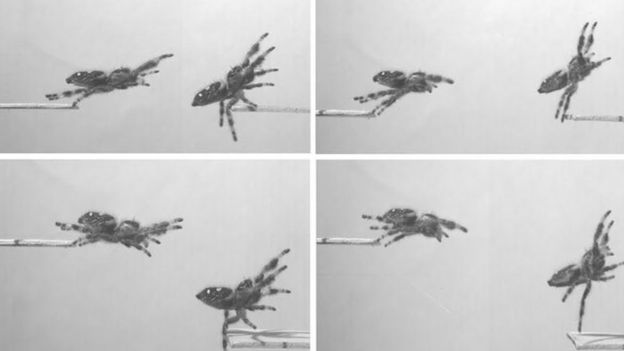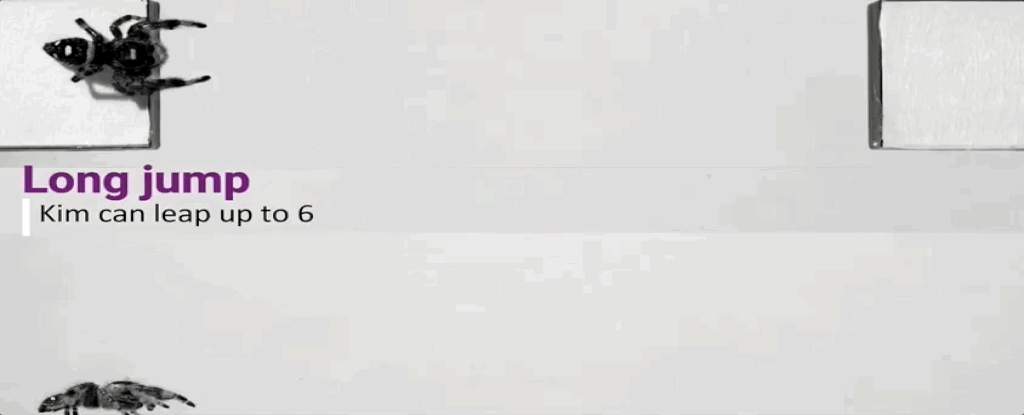Scientists have trained a spider to jump on command in the hopes that it will inspire a new generation of robots modelled on nature.
There are lots of spiders that have the ability to jump, and the regal jumping spider (Phidippus regius), which the researchers used in this particular study, is no misnomer.
The regal jumping spider's technique is impeccable, and when they leap to catch their prey, they can soar as far as six times their body length. This means at roughly 15 millimetres in length, these little fellas can jump at least 60 millimetres.
In comparison, humans can barely manage to jump 1.5 times our body length.
With their excellent vision and precise hunting style, the regal jumping spider was the perfect recruit for a new research project on micro jumping robots at the University of Manchester.
Teaching the female spiders to jump, however, was no easy task, and only one of the spiders really caught on to the idea of a take-off and landing platform. Her name was Kim.
The researchers filmed Kim's jumps with high-tech cameras to uncover the secrets behind her incredible leaps.
 (Scientific Reports)
(Scientific Reports)
The footage revealed that Kim had several different jumping techniques. At close range (roughly two body-lengths), Kim prefers a faster, lower trajectory for speed and accuracy. But for longer leaps (roughly six body-lengths), she tends to use a more energy-efficient jump.
While Kim can adjust the angle of her leap to jump higher or lower, the researchers noted she was more confident in the study jumping lower.
"She will jump at the optimal angle, which means that she can understand the challenge that she is presented with," microsystems engineer Mostafa Nabawy told Helen Briggs at the BBC.
"And then she can time her jumping performance at take-off to execute a jump that is optimal in terms of energy demand."
The researchers also noticed that Kim attached a "silk safety line" to the platform before taking off, which could be a way for the spider to stay stabilized as she jumps.
After carrying out 3D CT scans, the researchers were able to build a model for the spider's body and leg structure.
Analysis of the videos in combination with the models allowed the researchers to better understand the forces underlying the spider's jump.
While biologists know that spiders use hydraulic pressure from fluid in their legs to extend their limbs, it's still up for debate whether spiders can also use hydraulic pressure to enhance or even replace muscle power.
In this particular species, however, the researchers spider's muscle power alone was sufficient for the jump.
"Our results suggest that whilst Kim can move her legs hydraulically, she does not need the additional power from hydraulics to achieve her extraordinary jumping performance," says one of the team, aerodynamics researcher Bill Crowther.
"Thus, the role of hydraulic movement in spiders remains an open question."
Still, this study wasn't just about a deeper understanding of the regal jumping spider's anatomy. It also has important implications for building teeny tiny jumping robots.
If researchers can draw on the mysterious nature of jumping spiders, it could help solve some of the constraints that currently keep many robots firmly rooted to the ground.
Nabawy is an aeronautical engineer and he is especially interested in designing new types of flying and jumping robots. Kim's jump offers a few clues about how to make that dream a reality.
"The force on the legs at take-off can be up to five times the weight of the spider - this is amazing and if we can understand these biomechanics we can apply them to other areas of research," says Nabawy.
"Spiders have to plan everything, they have to execute accurate jumps and precise jumps to get their target [prey] as soon as possible and as accurately as possible."
After the spider part of the study was complete, the researchers built a simple jumping mechanism that was roughly the same size as the spider. But while the engineering structural materials were right, the project ultimately failed.
The scale that the researchers were trying to work with was just too small. They noted that "power and control electronics cannot compete with nature at this scale yet."
The researchers still plan on creating a functional robot from all this new information, but to do that, more research needs to be done, like examining how exactly jumping spiders control their jumps.
For now, engineering has got nothing on nature.
The study has been published in Scientific Reports.
